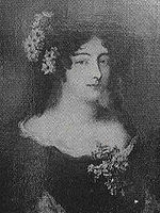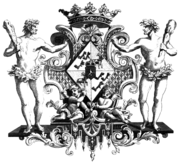
Ehrengard Melusine von der Schulenburg, Duchess of Kendal and Munster
Encyclopedia

Emden, Saxony-Anhalt
Emden is a village and a former municipality in the Börde district in Saxony-Anhalt, Germany. Since 1 January 2010, it is part of the municipality Altenhausen....
near Magdeburg. Her middle name was probably given in reference to the Melusine
Melusine
Melusine is a figure of European legends and folklore, a feminine spirit of fresh waters in sacred springs and rivers.She is usually depicted as a woman who is a serpent or fish from the waist down...
legends. Her brother was Marshal Johann Matthias von der Schulenburg
Johann Matthias von der Schulenburg
Reichsfreiherr and Reichsgraf Marshal Johann Matthias von der Schulenburg was a distinguished aristocrat and general of Brandenburg-Prussian descent who served in the Saxon and Venetian armies in the early eighteenth century and found a second career in retirement in Venice, as a grand...
. Her father was Gustavus Adolphus Baron von der Schulenberg.
When a Maid of Honour to the Electress Sophia of Hanover, she became a mistress of the Electoral Prince, George Louis
George I of Great Britain
George I was King of Great Britain and Ireland from 1 August 1714 until his death, and ruler of the Duchy and Electorate of Brunswick-Lüneburg in the Holy Roman Empire from 1698....
, and bore him at least three illegitimate children, including:
- Anna Luise Sophie von der Schulenburg, Countess of Dölitz (1692–1773), who married Ernst August Philipp von dem Bussche zu Ippenburg (1681 – 20 September 1761)
- Melusina von der Schulenburg, Countess of WalsinghamMelusina von der Schulenburg, Countess of WalsinghamPetronilla Melusine von der Schulenburg, 1st Countess of Walsingham was the illegitimate daughter of King George I of Great Britain and his longtime mistress, Melusine von der Schulenburg, Duchess of Kendal....
(1693–1778), who married Philip Stanhope, 4th Earl of ChesterfieldPhilip Stanhope, 4th Earl of ChesterfieldPhilip Dormer Stanhope, 4th Earl of Chesterfield PC KG was a British statesman and man of letters.A Whig, Lord Stanhope, as he was known until his father's death in 1726, was born in London. After being educated at Trinity Hall, Cambridge, he went on the Grand Tour of the continent... - Margaret Gertrude von der Schulenburg, Countess of Oeynhausen (1701–1726), who married Albrecht Wolfgang, Count of Schaumburg-Lippe.
George Louis succeeded as Elector of Hanover in 1698 and King of Great Britain (as George I) in 1714.
Melusine moved with him to England, and on 18 July 1716 was created for life Duchess of Munster, Marchioness of Dungannon, Countess of Dungannon and Baroness Dundalk, in the Peerage of Ireland
Peerage of Ireland
The Peerage of Ireland is the term used for those titles of nobility created by the English and later British monarchs of Ireland in their capacity as Lord or King of Ireland. The creation of such titles came to an end in the 19th century. The ranks of the Irish peerage are Duke, Marquess, Earl,...
. On 19 March 1719 she was further created Duchess of Kendal
Duke of Kendal
The titles of Earl of Kendal and Duke of Kendal have been created several times, usually for people with some connection to the royal family....
, Countess of Feversham
Earl of Feversham
Earl of Feversham is a title that has been created three times , once in the Peerage of England, once in the Peerage of Great Britain and once in the Peerage of the United Kingdom...
and Baroness Glastonbury
Baron Glastonbury
Baron Glastonbury is a title that was created twice in the Peerage of Great Britain. The first creation came on 19 March 1719 , as a life peerage and as a subsidiary title for Ehrengard Melusine von der Schulenburg, Duchess of Kendal and Munster, mistress of George I...
, in the Peerage of Great Britain
Peerage of Great Britain
The Peerage of Great Britain comprises all extant peerages created in the Kingdom of Great Britain after the Act of Union 1707 but before the Act of Union 1800...
.
In 1723, Charles VI, Holy Roman Emperor
Charles VI, Holy Roman Emperor
Charles VI was the penultimate Habsburg sovereign of the Habsburg Empire. He succeeded his elder brother, Joseph I, as Holy Roman Emperor, King of Bohemia , Hungary and Croatia , Archduke of Austria, etc., in 1711...
, created her Princess of Eberstein. This last creation in particular tended to support the theory that she had married the King in secret. Robert Walpole
Robert Walpole
Robert Walpole, 1st Earl of Orford, KG, KB, PC , known before 1742 as Sir Robert Walpole, was a British statesman who is generally regarded as having been the first Prime Minister of Great Britain....
said of her that she was "as much the queen of England as anyone was" (George's wife Sophia had been kept in imprisonment since their divorce in 1694).
The Duchess of Kendal was a very thin woman, being known in Germany as "the Scarecrow" and in England as "the Maypole". When in England, she lived principally at Kendal House in Isleworth
Isleworth
Isleworth is a small town of Saxon origin sited within the London Borough of Hounslow in west London, England. It lies immediately east of the town of Hounslow and west of the River Thames and its tributary the River Crane. Isleworth's original area of settlement, alongside the Thames, is known as...
, Middlesex
Middlesex
Middlesex is one of the historic counties of England and the second smallest by area. The low-lying county contained the wealthy and politically independent City of London on its southern boundary and was dominated by it from a very early time...
.
After George's death, she kept a raven she believed to be the dead king returned to visit her.
She died, unmarried (unless George I had wedded her), in 1743.
Her second cousin was Dorothea von Velen
Dorothea von Velen
Dorothea von Velen was the mistress of Johann Wilhelm, Elector Palatine. Born into an impoverished family of Berg nobility, she came to Johann Wilhelm's attention as a lady-in-waiting to his second wife, Anna Maria Luisa de' Medici...
, an advocate of religious toleration in the Palatinate.
External links
- thepeerage.com Retrieved August 3, 2010

